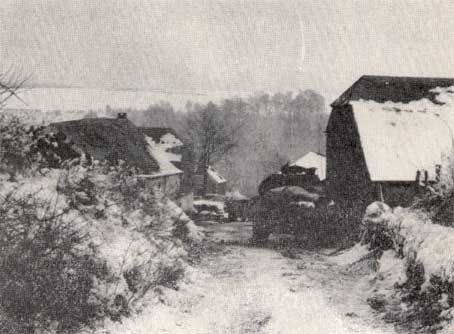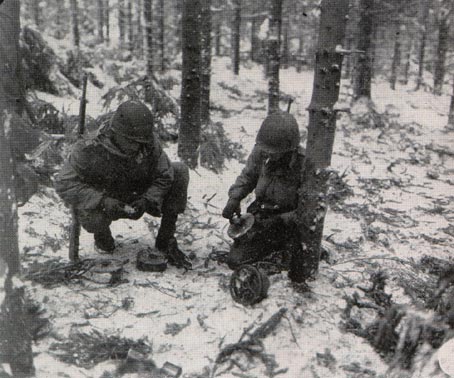| |
The Ardennes campaign for the U.S.
Army began on December 16, 1944 with a surprise and massive
German offensive under Gen. Von Runstedt along a 45 mile front
some 35 miles West of the Rhine River and due West of the
German cities of Cologne, Hamm, and Koblenz and following
the same routes through Luxembourg and Belgium taken by the
German armies in 1914 and again in 1940. The Allied command
had left that area thinly defended by four American Divisions
– the 99th, 4th, 28th and 106th – the latter just
arrived on the line fresh from the States and not yet battle
tested. Add to these a part of the 9th Armored Division and
the 14th Cavalry Group. Imagine the surprise to these Americans
when without warning, this quiet sector erupted in the pre-dawn
with an hour and a half barrage from all types of artillery,
then search lights through the morning fog, then coming through
that haze all along the sector tanks and infantry from 24
German Panzer and infantry divisions. Within hours the 106th
was overrun and destroyed, some 6,000 G.I.s taken prisoner,
the other units, badly mauled, were drive back in confusion,
split into small groups, isolated, fighting small individual
battles, to try to stop or slow the German onslaught. They
faced some 970 Panzer tanks and 800 Luftwaffe planes which
for several days penetrated through the mists and clouds which
covered the battlefields. Allied communications were badly
disrupted and battle reports distorted or not coming back
at all, creating confusion and uncertainties in all headquarters.

Ardennes-Tintange Belgium
For the 35th Division, some fifty miles to the South, and
bent on continuing its attack inside of Germany, little was
known about what the rest of the 3rd Army was doing, let alone
what was happening in the First Army whose VIIIth Corps had
been hit so hard. But rumors spread fast, like wildfire, in
an army, and we learned quickly that a major German offensive
had broken through in the North, with Germans in American
uniforms and using American equipment infiltrating or dropping
behind our lines. Rumors quickly became reports as on December
19th our own offensive was abruptly cut off and all along
our front we went into a defense, and three days later our
trucks loaded us and we soon arrived in rapidly deteriorating
winter weather in Metz, pulling up into a French army barracks,
there to receive brand new replacements and replacement equipment
and new rumors.

Laying Anti-Tank mines
The Germans had been pouring tanks and infantry through
the breaches in the American lines. The 101st Airborne Division
had been rushed in trucks to Bastogne, a Belgian communication
and road center about 22 miles North of Arlon, a town some
35 miles North of Metz. Bastogne was about 80 miles southeast
of Brussels and near the Luxembourg border, and a key objective
in the southern part of the Bulge. Parts of the 9th and 10th
U.S. Armored Divisions were in Bastogne and with the 101st
Airborne troops were on December 21st completely surrounded
by the Panzer Lehr and the 26th Volksgrenadier Division of
the German Fifth Army, along with the 2nd Panzer Division.
Gen. George Patton was ordered to counter attack with units
from this Third Army and he quickly transferred the 35th Division
to the Third Corps along with the 4th Armored Division and
the 26th Division. And on the 23rd of December sent these
three divisions to attack the German lines South of Bastogne,
and along the Arlon Highway with the mission of breaking through
to the Bastogne defenders and securing that corridor. The
35th Division got two more days including Christmas Day in
Metz to get ready to join the attack. The 4th Armored Division
moved North along and to the West of the Arlon Highway, against
determined German resistance, finally breaking through to
Bastogne on the 26th. To secure the corridor, the 35th Division
was ordered out of Metz on the same day and at 8 a.m. on December
27th, we attacked through knee deep snow to the East of the
Arlon Road, with the 137th Regiment on the left, the 320th
Regiment to the right, followed the next day by the 134th
Regiment which went into line to the left and West of the
137th Regiment. To our right was the 26th Division. Our line
of departure was about nine miles from Bastogne and for the
next two weeks we learned the meaning of freezing in hell
for we ran into some of the bitterest and most difficult fighting
of the war, the most wintry with temperatures dipping below
zero, and the costliest in terms of casualties. We attacked
and so did the Germans, from assault to stalemate, from defense
to counter-attack. Casualties were heavy on both sides, and
men would be hit and fall and freeze to death before they
could be gotten out. Corps men would have to keep blood plasma
under their arms to keep it from freezing. Trench feet, frozen
feet put men incapable of moving. We did not know that Hitler
had ordered some of his best remaining troops to cut off the
Third Army’s relief of Bastogne at all costs. Now across
our front from our right came the elite 1st S.S. Panzer “Der
Fuhrer” Division, sent down from the German Sixth Army
to break us – the 167th Volksgrenadier Division, and
the 5th Parachute Division from the Seventh German Army. Fighting
see-sawed in and around towns like Lutrebois where we lost
two companies of the 134th Regiment, Marvie, where we at last
broke through to the 101st Airborne, Surre, Villers La Bonne
where the 137th lost companies K and L, cut off and hit by
the Germans with flame throwers, the survivors captured and
marched into Germany to a prison camp, Boulaide, whose grateful
citizens would welcome returning veterans in later years as
tour groups, Tarchamps, and Harlange where a single farm,
fortified, stopped the 320th Regiment. Frostbite, illness
and exhaustion, the freezing waters of the Sure River, waste
deep, waded across by the 320th soldiers. Deep snow which
slowed attack and bogged down G.I.s who were unable to move
fast enough to evade the lethal fire of enemy machine guns,
mortars and artillery shells, tree bursts and craters. The
fields and woods became graveyards littered with dozens of
destroyed tanks and assault guns, half tracks, trucks, equipment,
and corpses. We saw the Adolph Hitler Division die before
us.
 Continue
to Page 2 of 3 Continue
to Page 2 of 3
|